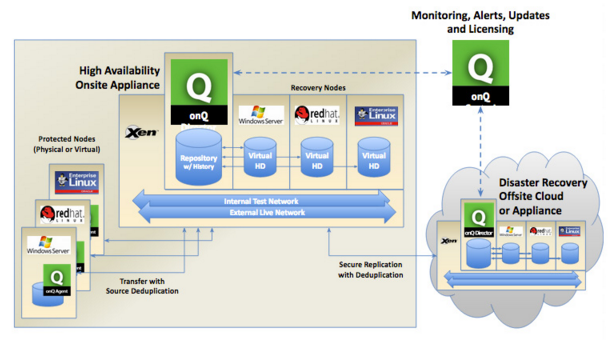 Quorum Technology
Quorum Technology
How We Do It
Quorum’s onQ appliance-based and Disaster Recovery as a Service (DRaaS) solutions go beyond online backup storage by keeping up-to-date, ready-to-run virtual machine clones of your critical systems. The service can be configured to keep the clones in Quorum’s hybrid cloud, local on the Quorum onQ appliance or any combination of both.
All components in the service (onQ appliance and Cloud) include hardware, storage and software needed to create, update, manage and synchronize multiple “Recovery Nodes” simultaneously over any network.
A single web based console integrates regular online backup/recovery based operations and lifecycle of recovery nodes for both physical and virtual machines, eliminating the need for multiple backup and DR products. A “One-Click” data recovery operation can be triggered via the console to start the recovery node on in the Quorum cloud or the local OnQ Appliance.

Core Technologies
- DCRM: our Distributed Computing Resource Management platform is the engine inside onQ. It is a powerful automation platform for monitoring and managing both virtual and physical computing resources. Originally developed for military applications, DCRM now provides Quorum with a powerful and extensible architecture that can go well beyond the current Disaster Recovery Solution capabilities of onQ.
- Global source deduplication: onQ only sends changes that don’t already exist on any other server at the site. This is done with low resource loading right at the source.
- Sub-file-level incremental updates: it is common for large files to have only small changes made to them. Some systems copy the entire file every time even a single byte changes. For large databases such as Exchange or SQL, this can cause gigabytes of unchanged data to be copied. onQ only send the changed “chunks”, and it does this without resorting to disk-block-based algorithms, which have some significant disadvantages. For example, onQ supports powerful regular expression matching for file and folder excludes which many block-based systems cannot do. Why back up temporary and junk files?
- Incremental Restore: Incremental allows one to add additional snapshots to a Bare Metal Restore or go back in time to a snapshot that had a successful self-test.
- Restore While Running: The restore of a server, from bare metal to incremental, does not require a shutdown of the recovery node except for the last set of incremental of changes.
- Continuous Backup: Even after the Recovery Node is started, we continue to back up the server.
- Full Backup: Unlike a typical tape backup where a full backup is usually done over the weekend, a Full Back Up is only done once. Incrementals are forever.
- Filter Driver (QFilter): Allows the onQ to keep track of disk drive changes as they occur on each volume. This can reduce the scan time significantly allowing backups to occur more frequently on critical servers like email and file servers.
- Continuous P2V: onQ keeps ready-to-run virtual machine “Recovery Nodes” (RNs) by merging incremental changes after each update interval. No other product does this for native virtualization (bare metal hypervisor) platforms.
- Continuous policy based DR testing: Continuous P2V and advanced networking allows regular and policy based testing of the DR infrastructure. The replicas can be started and tested on Premise or in the cloud without disrupting the production network. This key feature significantly increases the assurance level of the DR service compared to multi step systems that can only be tested with significant planning and disruption.
